I’m a Turkey!
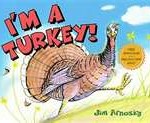 When I was little, I had a book with a 45 rpm record (yep, I’m that old) that I loved. It was “A Lot of Hot Water” read by Gordon from Sesame Street. Audio recordings of books have gone through a media transition or two, but it’s still a thrill to hear a good story read aloud by a talented reader. Jim Arnosky has a free downloadable MP3 version of his song “I’m a Turkey“, and my preschoolers this week gobbled it up. Arnosky’s folksy singing style is just right to get little listeners talkin’ turkey with him. The large art and short text in this book make it a fast, easy storytime choice. I’m going to share more books with cds or MP3 versions with my students. I’m sure they enjoy listening to another voice besides mine!
When I was little, I had a book with a 45 rpm record (yep, I’m that old) that I loved. It was “A Lot of Hot Water” read by Gordon from Sesame Street. Audio recordings of books have gone through a media transition or two, but it’s still a thrill to hear a good story read aloud by a talented reader. Jim Arnosky has a free downloadable MP3 version of his song “I’m a Turkey“, and my preschoolers this week gobbled it up. Arnosky’s folksy singing style is just right to get little listeners talkin’ turkey with him. The large art and short text in this book make it a fast, easy storytime choice. I’m going to share more books with cds or MP3 versions with my students. I’m sure they enjoy listening to another voice besides mine!
After sharing I’m a Turkey, we stretched by doing the Turkey Jerky. It’s like the Hokey Pokey, except you put your right wing in, your left wing, your tail feathers , etc. After announcing “that’s what it’s all about!”, we gobbled twice instead of clapping.
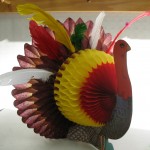 Next, I gave each student a feather from the craft store. I showed them this turkey decoration (the kind that folds flat to store but unfurls into a kind of fan for show) and we said this rhyme:
Next, I gave each student a feather from the craft store. I showed them this turkey decoration (the kind that folds flat to store but unfurls into a kind of fan for show) and we said this rhyme:
There was a little turkey who had lost his tail.
When he saw it was gone, he began to wail.
“Oh woe is me! Please tell me whether
You have found my red tail feather!”
Whoever had a red feather could stick the feather in one of the holes on the turkey. We repeated the rhyme and changed it until all the colors of the feathers were used. It took me less prep time to use the turkey decoration and feathers we already had than to make the bulletin board out of construction paper like I’d originally planned, and the students loved sticking in the real feathers. Having two easy, inexpensive activities to go with a book sung by a fun artist made me very thankful indeed!
For more information, visit jimarnosky.com.
Read More“Press Here” for fun!
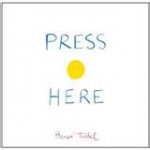 My dear friend’s daughter, Nora, turned one this month, and as a librarian, writer, and ardent-bordering-on-obsessive fan of children’s literature, I felt it my duty to include a book in her birthday bag o’ swag. Which book to choose? Press Here by Herve Tullet. Deceptively simple, it consists of dots and directions on what to do with them. Press the yellow dot and turn the page. Now there are two dots. Press the yellow dot again, and on the next page, now there are three dots. Tilt the book to the left, and on the next page, the dots seem to have slid to the left edge. Clap your hands to make the dots big, bigger, bigger. It is what electronic books wish they could be: it is interactive, delightful, and requires no batteries.
My dear friend’s daughter, Nora, turned one this month, and as a librarian, writer, and ardent-bordering-on-obsessive fan of children’s literature, I felt it my duty to include a book in her birthday bag o’ swag. Which book to choose? Press Here by Herve Tullet. Deceptively simple, it consists of dots and directions on what to do with them. Press the yellow dot and turn the page. Now there are two dots. Press the yellow dot again, and on the next page, now there are three dots. Tilt the book to the left, and on the next page, the dots seem to have slid to the left edge. Clap your hands to make the dots big, bigger, bigger. It is what electronic books wish they could be: it is interactive, delightful, and requires no batteries.
Considering that I had to pry Press Here from the hands of my 12- and 10-year-old children to put it in Nora’s gift bag, I can honestly say it’s not just for the littlest ones. My kids are no strangers to electronic games and they logically understand the way paper books work, but both of them followed all the instructions on the pages, like shaking the book to make the dots “move”. For toddlers, this book is magical. For kids who are building their reading skills, the simple text is engaging enough to read again, again, again. Press Here and see what happens!
Read MorePerfectly (Im)Perfect Square
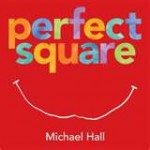 I fell in love with Perfect Square by Michael Hall when I first saw its vibrant, popsicle-colored pages. A square, with its four equal sides and four sharp corners, is perfectly happy, until it is cut into pieces and poked full of holes one Monday. But rather than groan about being ruined, the square takes its pieces and “made itself into a fountain that babbled and giggled and clapped.” On Tuesday, the square is torn to pieces that rearrange to make the flowers in a garden. Each day of the week, the square (painted in great swaths of colors that remind me of Eric Carle) is transformed, and the end of the story has a satisfying resolution that involves all the previous forms.
I fell in love with Perfect Square by Michael Hall when I first saw its vibrant, popsicle-colored pages. A square, with its four equal sides and four sharp corners, is perfectly happy, until it is cut into pieces and poked full of holes one Monday. But rather than groan about being ruined, the square takes its pieces and “made itself into a fountain that babbled and giggled and clapped.” On Tuesday, the square is torn to pieces that rearrange to make the flowers in a garden. Each day of the week, the square (painted in great swaths of colors that remind me of Eric Carle) is transformed, and the end of the story has a satisfying resolution that involves all the previous forms.
In preparation for my upcoming seminars, I’ve been spending a great deal of time studying the Common Core State Standards for kindergarten (if you, too, like spending evenings reading wordy documents about educational standards and benchmarks, check out corestandards.org) How do we teach the required standards and still include the books we love? Like this:
Share Perfect Square with your students. Read it first simply to enjoy a marvelous book. Read it again to the group and ask them about the wonderful vocabulary, “On Thursday, the square was shattered. What do you think shattered means? Let’s look at the picture.” Now we’re working on craft and structure, answering questions about unknown words. Take a picture walk through the book and have students explain what is happening. Now we’re integrating knowledge and ideas, hitting the kindergarten reading standard of linking the illustrations to the plot described in the words. Give students a square of colorful paper as an art extension activity to transform into something else. They’ll want to return to the book to see what author/illustrator Michael Hall did. Now we are actively engaging in group reading activities with purpose and understanding!
One cool story, three Common Core State Standards – all in a Perfect Square!
Read MoreWhat a Wonderful World!
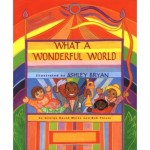 Ashley Bryan gorgeously illustrated the classic song written by George David Weiss and Bob Thiele to make a picture book perfect for your music-smart kids. Play Louis Armstrong’s version of the song for your little ones, and then sing-read this book. After listening, take little ones outside and look for colors. Use the phrasing from the book: “I see stop signs of red!” You can write on a sheet of paper: “I see ____ of ____.” Kids can complete the sentence and illustrate it for a classroom book, personal “What a Wonderful World” book, or bulletin board. Play the song while you make the art, and you’ll find yourself agreeing – it is a wonderful world!
Ashley Bryan gorgeously illustrated the classic song written by George David Weiss and Bob Thiele to make a picture book perfect for your music-smart kids. Play Louis Armstrong’s version of the song for your little ones, and then sing-read this book. After listening, take little ones outside and look for colors. Use the phrasing from the book: “I see stop signs of red!” You can write on a sheet of paper: “I see ____ of ____.” Kids can complete the sentence and illustrate it for a classroom book, personal “What a Wonderful World” book, or bulletin board. Play the song while you make the art, and you’ll find yourself agreeing – it is a wonderful world!







